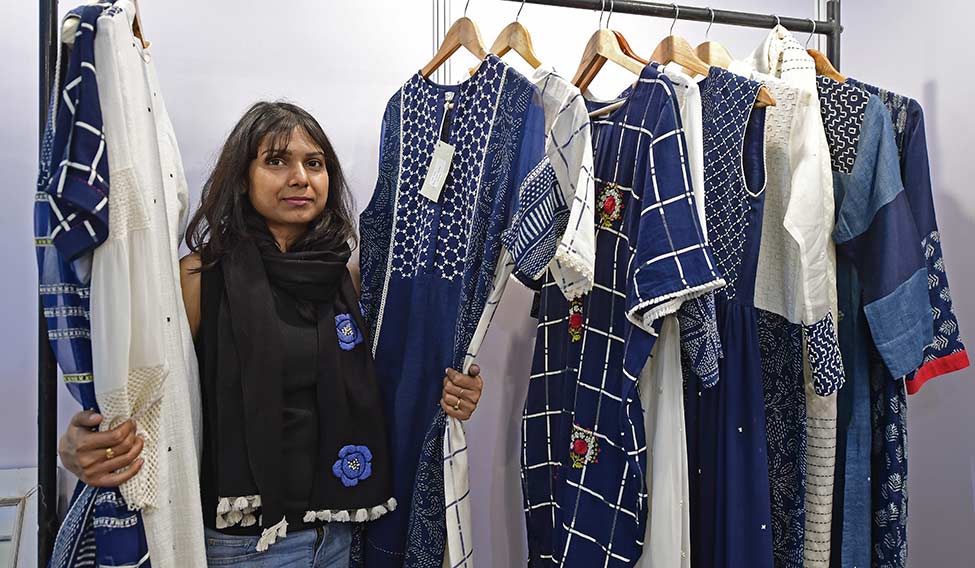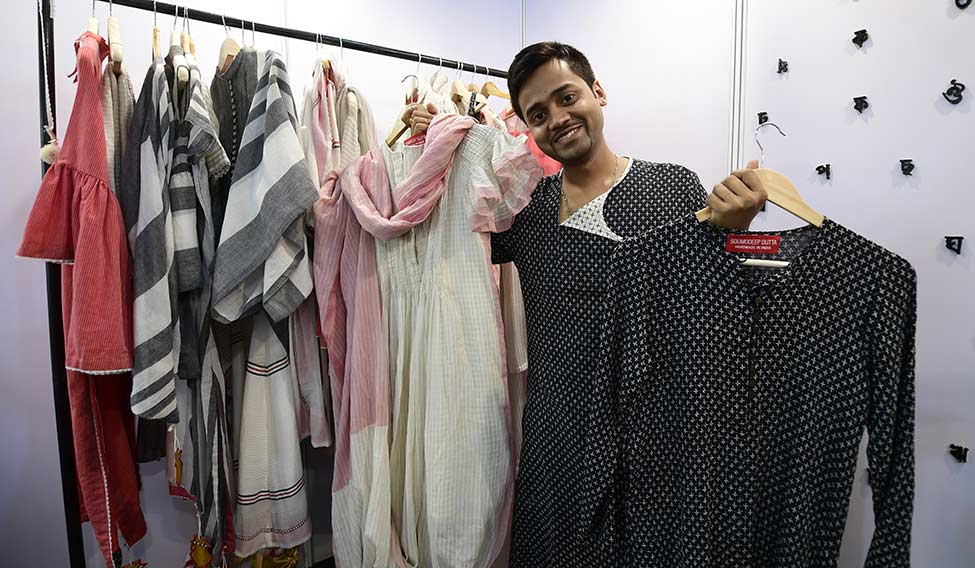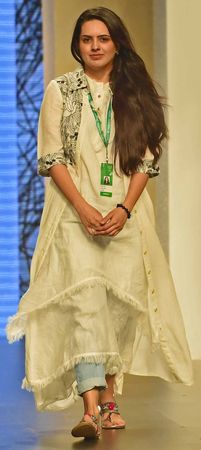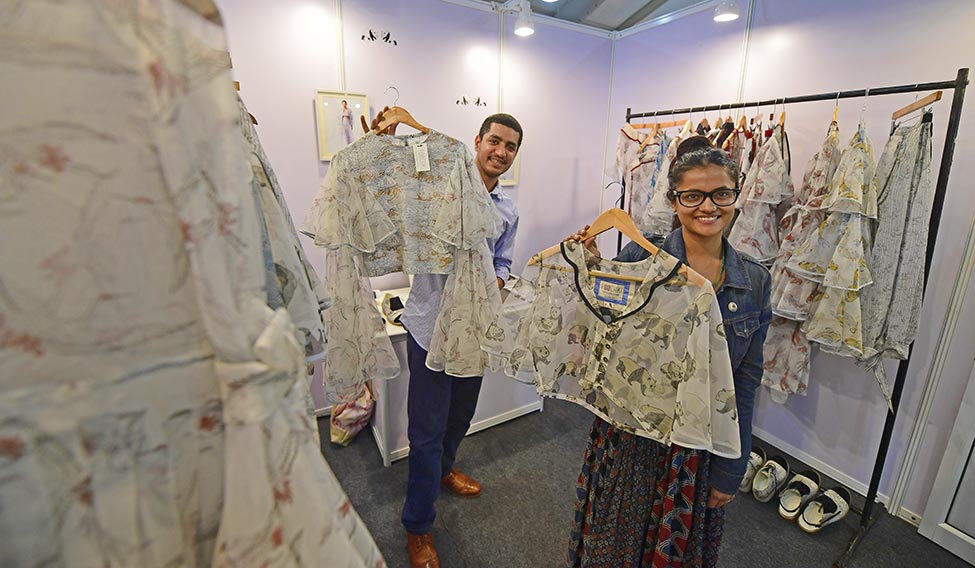Gen Next has been a regular fixture at the Lakmé Fashion Week (LFW) for more than a decade. Names such as Rahul Mishra and Masaba Gupta have emerged from this platform, and with every season a new freshness, in terms of design, is infused into the LFW, thanks to the younger talent—mostly independent labels that have been around for under three years. After several selection rounds, four to five designers, from thousands of entries, are chosen to showcase their talent at the LFW. And, this season was no different.
Inspiration is definitely the operative word for these talented youngsters. For New Delhi-based Anirudh Chawla and Ishanee Mukherjee, their inspiration has always been animals. Their label, Poochki, is also named after their pet cat. “Our first collection [2015] was about very city-focused, urban wildlife such as wasps but for this collection our hand block prints have been mostly inspired by the orient,” says Mukherjee. So, they have motifs of animals like pandas and tortoises from countries such as Japan and China.
 Design element: Pallavi Singh | Amey Mansabdar
Design element: Pallavi Singh | Amey Mansabdar
Resham Karmchandani and Sanya Suri of The Pot Plant drew their inspiration from what they saw around them. “People are now wearing what they like to wear,” says Suri. And so, they create garments that do not restrict their consumers to age-defining women’s or men’s wear.
Pallavi Singh of ARCVSH—which combines the names of her mother, Archana, and her husband, Santosh—derives inspiration from a place, its history and tradition, and picks elements from there and relates it to what Indians do. Her latest collection has been inspired by Japan as “they make simple things interesting in their own manner”. “I picked up their embroidery called Sashiko, which is quite similar to Kantha,” she says.
Soumyadeep Dutta’s brand is all about Indian design and has the essence of Bengal, where he comes from. For this collection, his inspiration was the “connecting link” between the opposites of nature such as day and night. “When these two meet, God is evoked,” he says. “In ancient ages, people wore the antariya and uttariya, which was wrapped around the body like a dhoti or a sari, and this collection has also been inspired from there, from the single drape.”
Kolkata-based fashion designer Nakita Singh describes her latest collection as “much more refined and mature”. Her collection has been inspired by ‘outline drawing’, the very first bit of raw sketches. The theme is tropical, so there is a lot of flora and fauna with a little bit of abstract.
 Soumyadeep Dutta | Amey Mansabdar
Soumyadeep Dutta | Amey Mansabdar
Chawla says they have “experimented with a lot of sheer fabrics because it makes one’s wardrobe very versatile”. The duo has experimented with silk organza and though they have used a lot of cotton in the past, all the opaque fabric this time around is modal. While Karmchandani and Sanya have used only 100 per cent cotton, Pallavi’s entire collection uses Indian-origin fabrics such as chanderi and matka cotton. Dutta has used the age-old Bengal muslin along with some lace details. Nakita’s choice of khadi and handloom cottons lend well to the fringe details in her collection to give it a messy look.
The shades in Poochki’s collection are mostly black, white and tones of grey. “Because of their sheer properties, we want these pieces to be versatile. If we were to use a lot of colour, chances are that they won’t go with them,” says Chawla.
Although Karmchandani and Suri have used lots of white, they have experimented with colours that are different so that buyers can transition smoothly from summers into monsoons. “The fashion industry is also moving away from the summer and winter colours. There are no defined seasons anymore,” says Karmchandani.
 Nakita Singh | Amey Mansabdar
Nakita Singh | Amey Mansabdar
Pallavi’s collection revolves around the indigo and ivory colour palette. “If you look at the Japanese dyeing technique, it is mostly indigo. It is a contemporary colour and I think it is the new black. Also, it goes very well with the Indian complexion,” she says. Her designs also have patches of colour such as red with fuchsia and green.
Dutta’s collection has colours such as black and white but you will also find shades of grey, which is representative of the time when dawn and dusk as well as black and white meet.
Nakita has mostly used ivory and black because “even when you draw, the base is always a white. That is why I have tried to keep the fabric as it is, just using the natural colour and adding the black thing as the graphical impact.”
‘Anti-fits’ is all the new rage, and Chawla and Mukherjee have experimented with it. “We try to do a lot of ‘anti-fits’ because we don’t do fitted stuff as sizing is a bit of a problem in this country,” says Mukherjee. “Gone are the days when women wanted to be stuck in these tight corsets. They are open to loose tees and shirts,” says Chawla.
The Pot Plant’s latest collection boasts ‘anti-fits’ that are “very clean”. “We just wanted to give people easy separates that they could style however they wanted,” says Suri. What you also will not see in their clothes is a lot of ruffles. “We do everyday cuts, easy to drive in, easy to hang out in. For us, life is in the pajamas. So, we want to do clothes that people are comfortable in. Yes, it should be ‘statement,’ but it should also be something that they want to wear because it is ‘different’,” says Karmchandani.
Though Pallavi has done a few ‘anti-fit’ shapes, she believes that at the end of the day women want to look beautiful and wear clothes that accentuate their curves. So, her creations “are a little away from the body but clinched at the waist. Even if you don’t have a narrow waist, it will make you look very feminine.”
Dutta has an interesting take on cuts. “Traditionally, we don’t believe in cuts. We feel if something tears, we must throw it away, as it carries negative connotations. Positivity comes from the running of it, when you don’t cut it. So, in my garments, I try not to give that cut, the whole garment is one stitched piece,” he says.
Dutta doesn’t go as far as calling his clothes ‘anti-fits’ but they are certainly not “darted and fitted” either. “Our Indian women’s waists aren’t slim, like western women, and they also have bigger hips. So, my clothes are not oversized but they are straight fitted,” he says.
As for Nakita’s clothes, she points out to how the silhouettes are comfortable and relaxed, yet they are not ‘anti-fits,’ which, she says, are “oversized” and end up making healthy people look fatter. Says Nakita: “It is just about how much breathable space one would require.”







